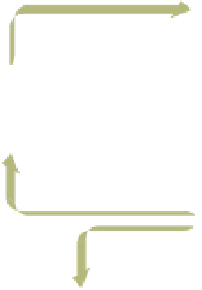Information Technology Reference
In-Depth Information
Figure 9.3 shows the traditional flow of key pieces of information from one TPS to
another for a typical manufacturing organization.
Customer order request
Figure 9.3
Order entry/
order configuration
Integration of a Firm's TPSs
Inventory status
Orders
Raw materials
Packing materials
Spare parts
Inventory
Finished product
inventory
Shipment planning
Purchase
order
request
Pick list
Inventory status report
Items and quantities
picked for each order
Purchase
order
processing
Purchase order
Shipment execution
Employee
Products
Purchase
order
Shipped orders
Materials
and
invoice
Invoice
Customer
Invoicing
Receiving
Supplier
Amounts owed by customer
Receiving notice
Employee
Payment
Accounts
receivable
Accounts payable
Time cards
Paychecks
Amounts owed by customers
Amounts owed by company
Amounts paid by company
Amounts paid by customers
Check
Labor costs
General ledger
Payroll
Budget
Expense
transactions
Because of the importance of transaction processing, organizations expect their TPSs to
accomplish a number of specific objectives including:
•
Capture, process, and update databases of business data required to support routine
business activities. Wal-Mart probably holds the world record, outside of the federal
government, processing some 800 million business transactions per day.
1
•
Ensure that the data is processed accurately and completely.
•
Avoid processing fraudulent transactions.
•
Produce timely user responses and reports.
•
Reduce clerical and other labor requirements.
•
Help improve customer service.
•
Achieve competitive advantage.
A TPS typically includes the following types of systems:
•
Order processing systems.
Running these systems efficiently and reliably is so critical
that the order processing systems are sometimes referred to as the “lifeblood of the
organization.” The processing flow begins with the receipt of a customer order. The
finished product inventory is checked to see if sufficient inventory is on hand to fill
the order. If sufficient inventory is available, the customer shipment is planned to meet
the customer's desired receipt date. A product pick list is printed at the warehouse from
which the order is to be filled on the day the order is planned to be shipped. At the
warehouse, workers gather the items needed to fill the order, and enter the item identifier
and quantity for each item to update the finished product inventory. When the order is
complete and sent on its way, a customer invoice is created with a copy included in the
customer shipment.
•
Accounting systems.
The accounting systems must track the flow of data related to all
the cash flows that affect the organization. As mentioned earlier, the order processing
system generates an invoice for customer orders to include with the shipment. This
information is also sent to the accounts receivable system to update the customer's

































